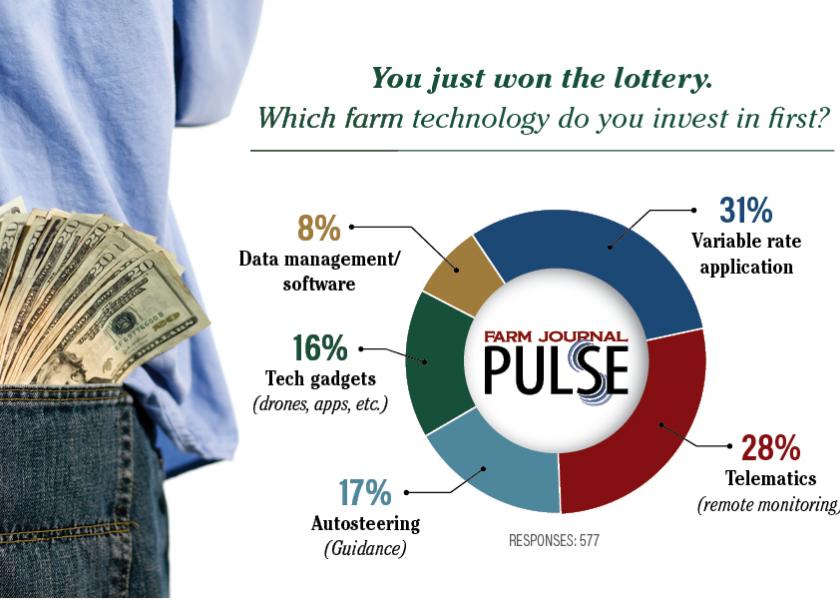Technology Is … Investing In Variable Rate

Adjusting inputs can yield $100 more per acre
As the corn market climbed $1 in just two weeks this spring, some farmers might have felt like they hit the jackpot. A recent Farm Journal Pulse found if farmers did in fact win the lottery, more than one-third said they would first invest in variable-rate technology (VRT).
Farm Journal Field Agronomist Ken Ferrie says the biggest obstacle to farmers implementing VRT is cost, including the presumed costs. This line of thinking is only focused on the short term, he says.
“Multiple farmers may be putting forth the same effort, but the VRT operator is netting anywhere from $63 to $100 per acre more profit than other growers [based on Farm Journal Test Plot research],” Ferrie says. “The reason for the difference is the VRT farmer understands their soils and uses VRT to apply the right inputs, at the optimum rate, on every acre.”
Admittedly, these profit calculations don’t include a charge for the technology.
“In so many cases, growers look at upfront costs, which vary based on where a grower is starting from,” Ferrie says. “If the farmer doesn’t have autosteer on the tractor, we have to start with GPS to control the monitors. Next, we have to outfit the planter. There are a lot of different ways to do that today and even older planters can be outfitted to do variable rate going across the field.”
THE PERFECT POPULATION
Washington County, Iowa farmer Mitchell Hora is seeing the benefits of variable rate firsthand. The Horas are mapping out zones based on organic matter and productivity. The approach allows them to vary population from 28,000 to 36,000, depending on the corn hybrid.
“In some of our better, higher organic matter soils we’ll bump the population up a little bit,” Hora explains. “We put in some ultra-low trials as well. Some of our corn is planted at only 20,000 plants per acre because it’s on really poor clay side hills that just burn up. Those acres are going to hardly make 100-bu. or 120-bu. corn anyway. We put 20,000 plants per acre out there to try to give the corn as much opportunity to retain water and be as competitive as possible. There’s no need to spend the extra money on the additional seed.”
Ferrie encourages farmers to plant different populations — from ultra-low to what seems too high — across a field, and then collect the yield data with a calibrated yield monitor. The data won’t just come in the form of yield, but also learning how topography and soil types change in the field, he says.
“We suggest planting a strip with the lowest population all the way across the field and the same for the highest population,” he says. “Then look at the soils because when the population goes up, the water and nitrogen demand go up and you have to be able to supply water and nitrogen for the crop.”
One of the mistakes Ferrie commonly sees is farmers failing to drop their planting population low enough on lighter soils. “It's not a matter of trying to push the population on heavy soils higher,” he says. “It’s taking those lower soils and lifting yields while reducing costs.”
FERTILITY FINESSE
As Hora pushes the envelope on plant population, he says the fertility side has become just as important. In return, he’s seeing savings on input expenses while increasing yields.
“By using variable rate, we’ve decreased our fertilizer by 45% in the past couple of years,” Hora says. “Improving our variable-rate management has allowed us to push the good yielding areas and drastically pull back in the poor yielding areas.”
With fertility decisions, he says it’s important to understand soil variability and soil biological variants to help create a more holistic crop management system.
While Hora is reaping the benefits of VRT, Ferrie says there might be some cases where the technology doesn’t pay. However, he says, those situations aren’t as common.
“Even in what we call our flat black soils in central Illinois, there are different water-holding capacities in a field. We can respond to those differences using VRT,” Ferrie says. “We put one population across the whole thing on a very small percentage of our fields.”
Ferrie says there’s no debate in the ROI of VRT if a farmer maximizes the technology to produce yield and cost-saving results.







